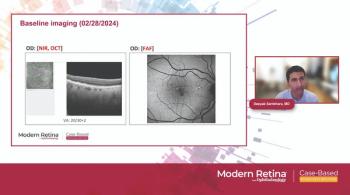
Early diabetic retinopathy detection may be found in biomarker changes
An Indonesian study of the characteristics of the retinal vasculature found that the retinal vessel tortuosity (VT) was significantly higher and the fractal dimension (FD) was significantly lower in patients with
Because diabetes is so rampant worldwide, the push is on to be able to identify DR earlier than what is currently possible, with the goal of saving vision.
The investigators commented, “DR is a common microvascular condition that frequently leads to blindness in both industrialized and poor countries. The current method of screening for DR involves visually examining fundus pictures to clinically assess the presence of DR. However, there is an urgent requirement for a screening method that can detect DR at an early stage, before it becomes clinically apparent.”2-5
They explained that retinal VT is an early sign of vascular changes in retinopathy, and low FD values indicate less frequent blood vessel branching patterns associated with the risk of cardiovascular mortality and advanced stages of DR.6-8
Fathimah and colleagues investigated retrospectively the differences in retinal VT and FD between patients with and without DR. They analyzed the medical records and optical coherence tomography (OCT)-A images of patients with and without DR. A vitreoretinal specialist graded the disease severity according to the International Clinical Diabetic Retinopathy and Diabetic Macular Edema Severity Scales. The patients were divided into 5 groups: as no DR, mild nonproliferative DR (NPDR), moderate NPDR, severe NPDR, and proliferative DR (PDR).
The study analyzed 96 patients (161 eyes) who were a mean age of 52.7 ± 9.9 years. The investigators found that the VT was significantly higher in all DR groups (p < 0.05): mild NPDR (β = +0.0621), moderate NPDR (β = +0.0412), severe NPDR (β = +0.0441), and proliferative DR (β = +0.0404). The FD of the superficial capillary plexus (SCP) did not differ significantly among the groups; the FD of the deep capillary plexus (DCP) was significantly lower compared with the groups with no PDR: moderate NPDR (β = -0.0131), severe NPDR (β = -0.0316), and PDR (β = -0.0326).
“Compared to the group with no DR, this study discovered a substantial rise in VT in patients with mild, moderate, and severe NPDR as well as PDR. This suggests that microvascular changes advance with the severity of the DR. Furthermore, a significant decrease in FD of the DCP was found in moderate NPDR, severe NPDR, and PDR. These findings underscore the necessity of evaluating specific retinal layers to gain deeper insights into the vascular changes linked to DR. If validated in larger studies, retinal vascular geometry could become a dual-purpose screening tool for both diabetic eye disease and systemic cardiovascular risk assessment,” Fathimah and colleagues concluded.
References
Fathimah FSN, Widjaja SA, Sasono W, et al. Retinal vessel tortuosity and fractal dimension in diabetic retinopathy. Int J Retina Vitr. 2025;11. Published online June 12.
https://doi.org/10.1186/s40942-025-00688-z Quinn N, Jenkins A, Ryan C, Januszewski A, Peto T, Brazionis L. Imaging the eye and its relevance to diabetes care. J Diabetes Invest. 2021;12:897–908.
Sayin N. Ocular complications of diabetes mellitus. World J Diabetes. [homepage on the Internet]. 2015;6(1):92. Available from:
http://www.wjgnet.com/1948-9358/full/v6/i1/92.htm Saghiri MA, Suscha A, Wang S, Saghiri AM, Sorenson CM, Sheibani N. Noninvasive temporal detection of early retinal vascular changes during diabetes. Sci Rep. 2020;10.
Li M, Wang G, Xia H, Feng Z, Xiao P, Yuan J. Retinal vascular geometry detection as a biomarker in diabetes mellitus. Eur J Ophthalmol. 2022;32:1710–1719.
Frizziero L, Midena G, Longhin E, et al. Early retinal changes by OCT angiography and multifocal electroretinography in diabetes. J Clin Med. 2020;9:1–14.
Agra CLDM, Lira RPC, Pinheiro FG, Sá LHSE, Filho VTFB. Optical coherence tomography angiography: microvascular alterations in diabetic eyes without diabetic retinopathy. Arq Bras Oftalmol. 2021;84(2):149–157.
Ari Widjaja S, Mieler WF, Sasono W et al. Retinal neurovascular alteration in type 2 diabetes with renal impairment in association with systemic arterial stiffness. Int J Retina Vitreous. 2024;10.
Newsletter
Keep your retina practice on the forefront—subscribe for expert analysis and emerging trends in retinal disease management.








































